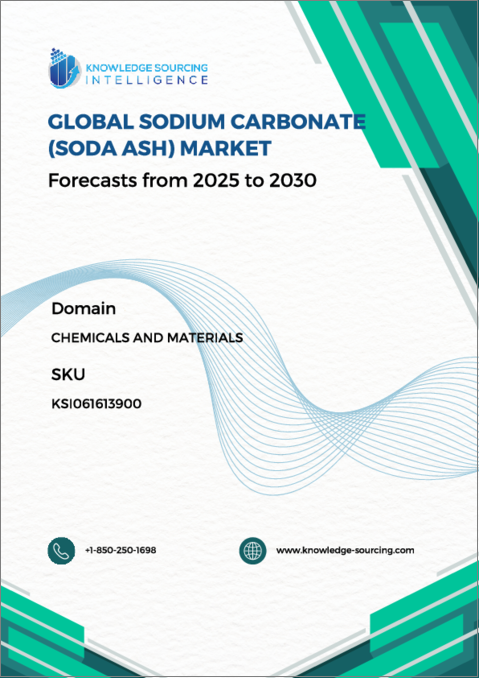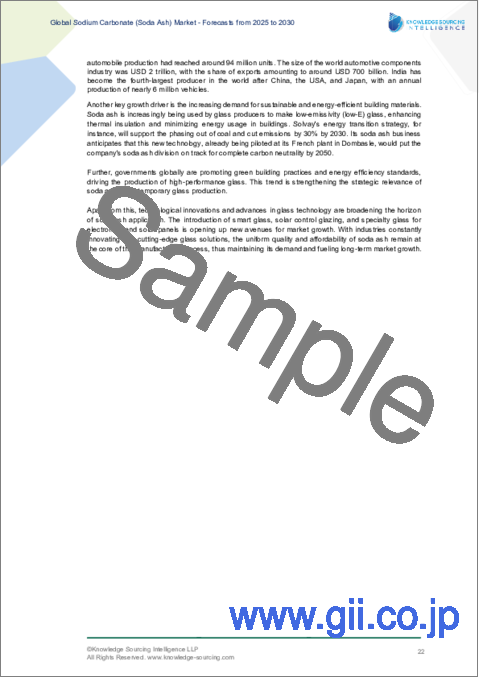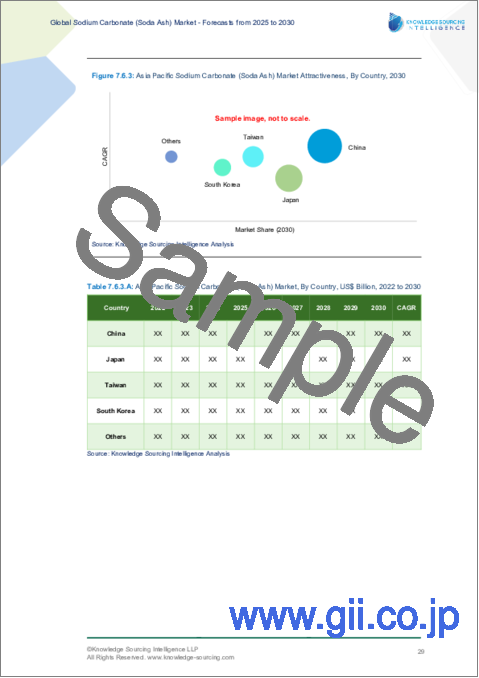|
|
市場調査レポート
商品コード
1457084
炭酸ナトリウム(ソーダ灰)市場-2024年から2029年までの予測Sodium Carbonate (Soda Ash) Market - Forecasts from 2024 to 2029 |
||||||
カスタマイズ可能
|
|||||||
| 炭酸ナトリウム(ソーダ灰)市場-2024年から2029年までの予測 |
|
出版日: 2024年02月29日
発行: Knowledge Sourcing Intelligence
ページ情報: 英文 145 Pages
納期: 即日から翌営業日
|
全表示
- 概要
- 目次
世界の炭酸ナトリウム(ソーダ灰)市場は、2022年の196億5,400万米ドルから2029年には286億4,700万米ドルに成長し、CAGR 5.53%で成長すると予測されています。
ソーダ灰は炭酸ナトリウム(ソーダ灰)としても知られ、ガラス、石鹸、洗剤、その他様々な工業用途の生産において重要な原料として役立っています。同市場は、世界のインフラ・プロジェクトへの多様な投資によって拡大する建設業界によって成長が見込まれています。米国では、化学薬品は最も広く使用されている必須製品のひとつであり、同国のGDPに大きく貢献しています。そのため、連邦準備制度理事会(FRB)は毎月のソーダ灰生産データを経済指標に組み込み、米国経済の全体的な状況を監視しています。市場は、種類によって密ソーダ灰と軽ソーダ灰に区分されます。
市場の促進要因
- 炭酸ナトリウム(ソーダ灰)市場の需要と市場成長を促進するエンドユーザー産業の成長拡大
ソーダ灰は、洗濯用や洗浄用の配合物に応用されています。油汚れの乳化を促進するなど、洗浄効果の向上に貢献します。その用途は、洗濯やすすぎ時の汚れの沈着を最小限に抑え、洗浄目的のためにアルカリ性を提供し、洗濯水の軟化を助けることにも及ぶ。さらに、ソーダ灰は、洗剤組成物における別の重要なビルダー、すなわちトリポリリン酸ナトリウム(STPP)の配合成分として重要な役割を果たします。さらに、ウルトラマリンの製造にも使用され、白い衣類の輝度を高める。米国環境保護庁の2022年の報告書によると、2019年に消費された炭酸ナトリウム(ソーダ灰)全体の47%近くがガラス製造に起因しています。化学産業は炭酸ナトリウム(ソーダ灰)総売上の約30%を占めました。2019年の国内消費の残りの部分は、商業市場の流通業者が6%、石鹸と洗剤が6%、雑多な用途が5%、排煙脱硫が4%、パルプと製紙が1%、水処理が1%でした。
2019年、米国における非燃料鉱物生産の推定総額は863億米ドルに達し、前~20億米ドル増加しました。2020年の報告書によると、米国は依然として様々な原材料や加工鉱物原料を海外に依存しています。2019年の非燃料鉱物46品目の見かけの消費量の半分以上を輸入が占め、そのうち17品目について米国は100%純輸入に依存していました。重要な希土類鉱物精鉱の国内生産量は、2019年に8,000トン(44%以上)と大幅に増加し、合計2万6,000トンに達しました。これにより米国は、中国を除くレアアース鉱物精鉱の最大の生産国となりました。2019年、米国における金属鉱山の推定生産額は281億であり、2018年と比較して約5億の増加となりました。2018年の金属鉱山生産額全体への主要貢献者は、金(32%)、銅(28%)、鉄鉱石(19%)、亜鉛(7%)でした。
市場の成長を後押しする市場開拓
- 2022年5月、Solvayはワイオミング州グリーンリバーの天然ソーダ灰施設の完全所有権を取得しました。Solvayは、米国ワイオミング州グリーンリバーにあるソーダ灰合弁事業において、AGCが保有する残り20%の少数株主持分の買収を明らかにし、トロナ系ソーダ灰製造における支配的な役割を強化しました。
- 2023年9月23日、タミル・ナードゥ州のV.O. Chidambaranar港湾局は、Tuticorin Alkali Chemical and Fertilizers Ltd(TFL)社向けに、エジプトのダミエッタ港から到着した総重量37.4トンのISOグリーンアンモニアコンテナ3x20個の取り扱いに成功しました。従来、グレー・アンモニアはソーダ灰製造に使用されていました。ゴー・グリーン・イニシアチブの一環として、TFLはグリーン・ソーダ灰の試験製造用にグリーン・アンモニアを輸入しました。さらにTFLは、グリーン・アンモニアの入手可能性を条件として、今年2,000MTの輸入を計画しています。
北米は、炭酸ナトリウム(ソーダ灰)市場の後続成長が期待されます。
米国は天然炭酸ナトリウム(ソーダ灰)鉱床の世界の主要拠点であり、世界最大級の貯水池を支配しています。米国は、その世界の製造業の卓越性だけでなく、炭酸ナトリウム(ソーダ灰)の実質的な国内供給・流通網を維持しています。例えば、天然ソーダ灰(炭酸ナトリウム(ソーダ灰))の国内生産量は1,200万トンで、前~20%増加しました。にもかかわらず、米国のソーダ灰業界は、生産者の数が限られており、生産拠点が分散しているのが特徴で、主に2つの地域に集中しています。ワイオミング州には5つの施設を運営する4つの会社があり、カリフォルニア州には1つの会社が管理する1つのプラントがあります。
天然ソーダ灰の生産者は、合成ソーダ灰の生産者よりも生産コストが低く、環境フットプリントが少ないという明確な利点を享受しています。合成ソーダ灰の製造工程は、天然ソーダ灰の製造に比べ、一般的に高いエネルギー消費と二酸化炭素排出を伴う。近年、世界的にいくつかの合成ソーダ灰工場が閉鎖されたり、操業が停止されたりしています。このことは、アメリカの天然ソーダ灰メーカーが市場でのプレゼンスを拡大する機会を生み出しています。
目次
第1章 イントロダクション
- 市場概要
- 市場の定義
- 調査範囲
- 市場セグメンテーション
- 通貨
- 前提条件
- 基準年と予測年のタイムライン
第2章 調査手法
- 調査データ
- 調査プロセス
第3章 エグゼクティブサマリー
- 調査ハイライト
第4章 市場力学
- 市場促進要因
- 市場抑制要因
- ポーターのファイブフォース分析
- 業界バリューチェーン分析
第5章 世界の炭酸ナトリウム(ソーダ灰)市場:タイプ別
- イントロダクション
- 重ソーダ灰
- 軽ソーダ灰
第6章 世界の炭酸ナトリウム(ソーダ灰)市場:用途別
- イントロダクション
- ガラス
- 石鹸と洗剤
- 化学薬品
- 鉱業
- 紙・パルプ
- その他
第7章 世界の炭酸ナトリウム(ソーダ灰)市場:地域別
- イントロダクション
- 北米
- 南米
- 欧州
- 中東・アフリカ
- アジア太平洋
第8章 競合環境と分析
- 主要企業と戦略分析
- 市場シェア分析
- 合併、買収、合意とコラボレーション
第9章 企業プロファイル
- CIECH S.A.
- Solvay
- Ciner Resources Corporation
- Tata Chemicals Ltd.
- Genesis Energy, LP
- Tangshan Sanyou Chemical Industries Co., Ltd.
- Shandong Haihua Group
- Nirma Limited
- Joint-stock company "Bashkir soda company"(JSC "BSC")
- GHCL Limited
- Tokuyama Corporation
- Seqens Group
- Natrium Products Inc.
- Hawkins, Inc.
The global sodium carbonate market is anticipated to grow from US$19.654 billion in 2022, to US$28.647 billion by 2029, growing at a CAGR of 5.53%.
Soda Ash, also known as sodium carbonate, serves as a crucial raw material in the production of glass, soaps, detergents, and various other industrial applications. The market is expected to witness growth driven by the expanding construction industry, marked by diverse investments in global infrastructure projects. In the United States, chemicals rank among the most widely used and essential products, contributing significantly to the country's GDP. Consequently, the Federal Reserve Board incorporates monthly soda ash production data into its economic indicators to monitor the overall condition of the U.S. economy. The market is segmented into dense soda ash and light soda ash based on type.
MARKET DRIVERS:
- Expanding growth of end user industries to drive demand and market growth of sodium carbonate market
Soda ash finds application in formulations for laundry and cleaning compounds. It contributes to improved cleansing efficacy, such as serving as a builder in the emulsification of oil stains. Its usage extends to minimizing dirt deposition during washing and rinsing, providing alkalinity for cleaning purposes, and aiding in the softening of laundry water. Additionally, soda ash plays a crucial role as a constituent in the formulation of another significant builder in detergent compositions, namely sodium tripolyphosphate (STPP). Moreover, it is employed in the production of ultramarine, enhancing the brightness of white clothing. According to a 2022 report from the US Environmental Protection Agency, in 2019, nearly 47% of the total sodium carbonate consumed was attributed to glass manufacturing. The chemical industry accounted for approximately 30% of total sodium carbonate sales. The remaining portion of domestic consumption in 2019 comprised commercial market distributors at 6%, soaps and detergents at 6%, miscellaneous applications at 5%, flue gas desulfurization at 4%, pulp and paper at 1%, and water treatment at 1%.
In 2019, the total estimated value of nonfuel mineral production in the United States reached $86.3 billion, marking a $2 billion increase from the previous year. The 2020 report indicates that the U.S. still depends on foreign sources for various raw and processed mineral materials. Imports accounted for over half of the apparent consumption of 46 nonfuel mineral commodities in 2019, and the U.S. was 100% net import reliant for 17 of them. The domestic production of critical rare-earth mineral concentrates saw a significant increase of 8,000 metric tons (over 44%) in 2019, reaching a total of 26,000 metric tons. This positioned the U.S. as the largest producer of rare-earth mineral concentrates outside of China. In 2019, the estimated value of metal mine production in the United States was 28.1 billion, representing an increase of nearly 500 million compared to 2018. The primary contributors to the overall value of metal mine production in 2018 were gold (32%), copper (28%), iron ore (19%), and zinc (7%).
Market developments to bolster the growth of the market.
- In May 2022, Solvay obtained full ownership of its natural soda ash facility in Green River, Wyoming. Solvay revealed the purchase of the remaining 20% minority stake held by AGC in the Soda Ash joint venture located in Green River, WY, USA, strengthening its dominant role in trona-based soda ash manufacturing.
- On September 23, 2023, the V.O. Chidambaranar Port Authority in Tamil Nadu successfully managed the handling of 3x20 ISO Green Ammonia Containers, with a total weight of 37.4 tons of Green Ammonia, arriving from Damietta Port, Egypt, for M/s. Tuticorin Alkali Chemical and Fertilizers Ltd (TFL). Traditionally, Grey Ammonia is used in soda ash production. In line with the Go Green initiative, TFL has imported green ammonia for the trial production of Green Soda Ash. Additionally, TFL has plans to import 2000 MT this year, contingent upon the availability of Green Ammonia.
North America is expected to witness subsequent growth in the sodium carbonate market.
The United States stands as the primary global hub for natural sodium carbonate deposits, controlling some of the largest reservoirs worldwide. Beyond its global manufacturing prominence, the U.S. maintains a substantial domestic supply and distribution network for sodium carbonate. For instance, domestic production yielded twelve million tons of natural soda ash (sodium carbonate), marking a 20% increase from the previous year. Despite this, the U.S. soda ash industry is characterized by a limited number of producers and dispersed production sites, primarily concentrated in two regions. Wyoming houses four companies operating five facilities, while California hosts one plant under the management of a single company.
Natural soda ash producers enjoy distinct advantages over synthetic counterparts, marked by lower production costs and a reduced environmental footprint. The manufacturing process of synthetic soda ash typically entails higher energy consumption and greater carbon dioxide emissions compared to the production of natural soda ash. Recent years have witnessed the closure or inactivity of several synthetic soda ash plants globally. This creates opportunities for American manufacturers of natural soda ash to expand their market presence.
Market Segmentation
By Type
- Heavy soda ash
- Light soda ash
By Application
- Glass
- Soaps and Detergents
- Chemicals
- Mining
- Paper and Pulp
- Others
By Geography
- North America
- USA
- Canada
- Mexico
- South America
- Brazil
- Argentina
- Others
- Europe
- UK
- Germany
- France
- Spain
- Others
- Middle East and Africa
- Saudi Arabia
- UAE
- Israel
- Others
- Asia Pacific
- Japan
- China
- India
- Australia
- South Korea
- Thailand
- Others
TABLE OF CONTENTS
1. INTRODUCTION
- 1.1. Market Overview
- 1.2. Market Definition
- 1.3. Scope of the Study
- 1.4. Market Segmentation
- 1.5. Currency
- 1.6. Assumptions
- 1.7. Base, and Forecast Years Timeline
2. RESEARCH METHODOLOGY
- 2.1. Research Data
- 2.2. Research Process
3. EXECUTIVE SUMMARY
- 3.1. Research Highlights
4. MARKET DYNAMICS
- 4.1. Market Drivers
- 4.2. Market Restraints
- 4.3. Porter's Five Forces Analysis
- 4.4. Industry Value Chain Analysis
5. GLOBAL SODIUM CARBONATE (SODA ASH) MARKET, BY TYPE
- 5.1. Introduction
- 5.2. Heavy Soda Ash
- 5.3. Light Soda Ash
6. GLOBAL SODIUM CARBONATE (SODA ASH) MARKET, BY APPLICATION
- 6.1. Introduction
- 6.2. Glass
- 6.3. Soaps and Detergents
- 6.4. Chemicals
- 6.5. Mining
- 6.6. Paper and Pulp
- 6.7. Others
7. GLOBAL SODIUM CARBONATE (SODA ASH) MARKET, BY GEOGRAPHY
- 7.1. Introduction
- 7.2. North America
- 7.2.1. By Type
- 7.2.2. By Application
- 7.2.3. By Country
- 7.2.3.1. United States
- 7.2.3.2. Canada
- 7.2.3.3. Mexico
- 7.3. South America
- 7.3.1. By Type
- 7.3.2. By Application
- 7.3.3. By Country
- 7.3.3.1. Brazil
- 7.3.3.2. Argentina
- 7.3.3.3. Others
- 7.4. Europe
- 7.4.1. By Type
- 7.4.2. By Application
- 7.4.3. By Country
- 7.4.3.1. UK
- 7.4.3.2. Germany
- 7.4.3.3. France
- 7.4.3.4. Italy
- 7.4.3.5. Spain
- 7.4.3.6. Poland
- 7.4.3.7. Others
- 7.5. Middle East and Africa
- 7.5.1. By Type
- 7.5.2. By Application
- 7.5.3. By Country
- 7.5.3.1. UAE
- 7.5.3.2. Israel
- 7.5.3.3. Saudi Arabia
- 7.5.3.4. Others
- 7.6. Asia Pacific
- 7.6.1. By Type
- 7.6.2. By Application
- 7.6.3. By Country
- 7.6.3.1. Japan
- 7.6.3.2. China
- 7.6.3.3. India
- 7.6.3.4. Australia
- 7.6.3.5. South Korea
- 7.6.3.6. Indonesia
- 7.6.3.7. Others
8. COMPETITIVE ENVIRONMENT AND ANALYSIS
- 8.1. Major Players and Strategy Analysis
- 8.2. Market Share Analysis
- 8.3. Mergers, Acquisitions, Agreements, and Collaborations
9. COMPANY PROFILES
- 9.1. CIECH S.A.
- 9.2. Solvay
- 9.3. Ciner Resources Corporation
- 9.4. Tata Chemicals Ltd.
- 9.5. Genesis Energy, LP
- 9.6. Tangshan Sanyou Chemical Industries Co., Ltd.
- 9.7. Shandong Haihua Group
- 9.8. Nirma Limited
- 9.9. Joint-stock company "Bashkir soda company" (JSC "BSC")
- 9.10. GHCL Limited
- 9.11. Tokuyama Corporation
- 9.12. Seqens Group
- 9.13. Natrium Products Inc.
- 9.14. Hawkins, Inc.





